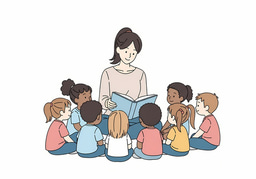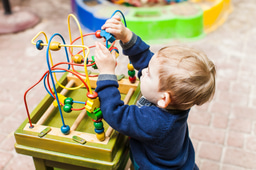Risky play in the early years

Introduction
Overtime, for many reasons, including the advancement of technology and a greater concern over the safety of children, children are spending less time outside and are being more closely supervised by adults around them. There has also been an increase in accountability and subsequent consequences which adults are held to if a child does come to harm while under their care. Although keeping children safe should always be the foremost priority, there are increasing concerns that as a society we have become too risk adverse. What is meant by the term ‘risk adverse’ is that we are trying to eliminate all risks to avoid any potential harm from happening. On the surface this may seem like the best approach to keeping children safe, however, avoiding risks all together can actually have a detrimental impact on their learning and development, which can also lead to further challenges in adulthood. The aim of this article is to look at what risky play is and the importance of it. I will also provide some good practice tips and suggestions of activities which you can implement within your own practice to support the learning and development of young children.
What is risky play?
In early years practice, the term ‘risky play’ refers to play activities and opportunities which encompass a degree of challenge with an associated risk of physical or emotional harm. For example, allowing a child to climb a tree. This activity presents a young child with a challenge: they have to climb/move/pull their bodies to enable them to climb it, but it comes with the associated risk that they could fall and injure themselves.
You could completely eliminate the potential risk of them injuring themselves by not letting them climb the tree. However, this would be a missed learning opportunity as enabling them to climb the tree would support their physical development as they must manoeuvre their bodies in different ways and pull themselves up. Children could also work together in small groups to problem solve and discuss the best way that they could climb the tree, which provides an opportunity for them to develop their personal, social and emotional skills, as well as their communication and thinking. Once a child has climbed the tree it can also give them a sense of achievement which can boost their self-confidence and self-esteem.
Alternatively, rather than taking this learning opportunity away, you could put measures in place to reduce the potential risk of harm, such as telling the children that they can only climb to a certain point in the tree, the area around the base of the tree is clear from debris and you position yourself nearby to be readily on hand if they need some help. Although a child could still hurt themselves by falling or getting scratched by a branch, the level of injury as a result of that is not envisioned to be significant.
Why is it important in early years?
Enabling children to take risks not only supports their learning and development in their early years but also helps them to learn life skills that will support them in being able to manage risks in their adulthood. As adults, we make life decisions every day, all of which carries a potential risk of harm. However, as adults we do not always have someone readily on hand to ‘catch us if we fall,’ or to supervise us when we attempt a new challenge. Therefore, the potential risk of harm can be more substantial if we have not learned effectively about cause and effect or that every action has a reaction or consequence. Learning about risk, including, assessing and managing risks in early childhood, can create a safer adulthood for children.
For example, if you never let a child jump from a height, such as from a piece of play equipment or a bench, they will not have learned about how to identify, manage and judge what is a safe height for them to jump from. As young adults, there will not necessarily be an adult around them telling them not to jump off something and they could make a spontaneous decision to jump off something high because they have not done it before and it seems exciting, and again there is no one to tell them they cannot. This could result in serious and significant injury as they have not been able to identify, assess and manage the risk effectively as they have missed key learning opportunities in their childhood which supports the development of these important life skills.
Furthermore, engaging in risky play in early childhood supports self-confidence and resilience. A child might climb a tree, fall and graze their knees but with some encouragement from an adult they will understand that it is ok for them to fall, they have hurt themselves, but they can still get back up and try again. If as children we do not learn how to be resilient and know that even though we may fall and we may hurt ourselves, we can always get back up and try again, in adulthood we would be less resilient and more likely to have poor mental health and wellbeing as we could potentially be discouraged from the very first time we ‘fall’ and not have the self-confidence to try again.
Using the climbing of a tree as an analogy, in the context of adulthood, the tree would represent a real-life situation such as a job or relationship. For example, as an adult you may gain employment (your first step into the tree), you work in that job for a while (you are climbing the tree) but then unexpectedly you lose your job (you fall out of the tree). You find yourself unemployed, which may have some financial implications (you are injured from the fall), but you have learnt in childhood that although it ‘hurt’ you are ok, and you pick yourself up and try again (you put your foot back on the tree and look for another job).
Therefore, risky play in early years can support young children in developing physical and emotional capacity and will enable them to learn about risks, including how to identify, manage and make informed decisions about what risks they should take. Furthermore, risky play will help children to build self-confidence, their independence and resilience. The development of all these key skills and attributes will subsequently help prepare them for the real world where there will inevitably encounter elements of risk as part of day-to day life.
What constitutes risky play?
The example of letting a young child climb a tree is just one example of a risky play activity/opportunity. However, it does illustrate the key features of what risky play should include: challenging and exciting/thrilling. Risky play should always have an element of challenge to it; however, the challenge should be somewhat achievable. If it is too challenging and beyond their age and developmental ability and a child is unable to complete the challenge after a few attempts, they will quickly become frustrated and lose motivation. As well as being challenging, risky play should also have a sense of excitement/thrill about it. Once the activity/event has been completed, a child should experience a sense of exhilaration.
As well as climbing trees, risky play can include, but is not limited to:
- Climbing play equipment, structures and ladders
- Jumping and landing from heights and rolling down hills
- Playing at speed such as running, sliding, swinging and riding bikes, scooters or using roller skates and skateboards
- Using real-life tools such as hammers, saws, drills and knives (with direct supervision and prior instructions on how to use them safely)
- Rough and tumble play is a great way for children to play together and can involve wrestling or chasing each other. You should supervise this type of play and step in if the play is getting ‘too rough’ or it no longer appears to be playful and becomes more aggressive
- Playing with natural elements such as being near open water (by the sea or a lake) climbing on rocks or by a fire such as when toasting marshmallows
- Hide and seek is a good way for children to experience the sense of disappearing and of being lost, with the excitement of then being found
It is important to remember, risky play will look different for each child, dependent on their age and stage of development as well as their level of need. Not all children can (or will want to) climb a tree or ride a bike down a steep hill. A child may have a physical or sensory disability which means opportunities for risky play need to be adjusted for them and they may require more support to ensure that they can still engage in that challenge and experience the excitement. Whatever risky play looks like for the children you are caring for, you should always plan opportunities and incorporate risky play into their day.
Risky play policy and procedures
As early years practitioners, your setting should have a risky play policy in place which all staff should acknowledge, and it should be shared with parents. Parents should also be given the opportunity to talk to you if they have any questions or concerns regarding risky play. Your policy should outline what risky play is and how it can support their child’s learning and development. It should highlight what risky play looks like in your setting and how/in what ways the children will be supported and encouraged to engage in it. You should set clear procedures and have risk assessments in place for each type of risky play activities/opportunities which identifies the potential risks/hazards and the preventative measures you will take to reduce the risk/hazards. You should also have staff trained in first aid to be able to act immediately if an accident/injury does happen. As with all policies, procedures and risk assessments, they should be regularly reviewed, amended as needed and updated regularly.
Conclusion
As a society our perspectives on children’s play have changed over time, as has our need to keep children safe from harm. Although keeping a child safe is, and always should be, the first and foremost priority of parents and practitioners, in doing so we could inadvertently be taking key learning opportunities away from children. This could have a detrimental impact on their development in childhood and can adversely affect their adulthood. Risky play can provide many benefits to children’s learning, development and overall mental health and wellbeing. Rather than completely avoiding risk, as early years practitioners you should be providing children with age and developmentally appropriate opportunities to engage in risky play. With clear and robust policies, procedures and risk assessments, together with adult supervision and support, you can minimize the potential risk of serious injury happening, without having to compromise or completely taking away the challenge or excitement that comes with this type of play.





Please sign in or register for FREE
If you are a registered user on SEND Network, please sign in
Useful information- thank you. It may be helpful to prompt adults to reflect on how they engage and interact with children taking a risk, relative to the child's experience and capacity. When the adult looks anxious (or scared) it can impact how a child interprets the situation.
This is a very important article that aims to recapture the essential learning through play that we have increasingly lost over the years. It is much about ressurecting the sort of fundamental play children used to engage with generations ago, before the introduction of smart phones and other screens, etc. It is similar to the principle behind the need for 'unsupervised play' enabling children the freedom to directly experience the world through their own experimentation with trial and error. In this way, the physical, psychologocial and cognitive aspects of learning start to join up and amount to a much deeper more profound level of learning than through the abstract lessons of what a child can be taught second or third hand, via an older adult or machine.
The principles here also reinforce how valuable it is for children to engage with day to day practical activities alongside an adult, copying and practising the skills involved. We see from watching young children that the things they are most interested in doing are those they see being performed by adults close to them. This is certainly for an evolutionary reason, to ensure that essential skills are passed on. We deny children the opportunity to do so at our peril and deprive them of critical learning that will enable them to adapt to the adult world.
In addition, encouraging children to engage with adults in this way, takes the load away from adults of feeling that the only way to ligitimately interact with their young children, is to discontinue with their own activities and play with specially adapted, risk free toys. This can put a strain on the relationship, when a parent feels there are lots of more important jobs to be done. Whereas the joy that can be gained from sharing those jobs with the children and helping them learn the skills they need to become proficient at them, can be a powerful force of family bonding.
A friend of mine regularly took his children with him on hot air balloon flights from the age of three upwards. One of them grew up to gain her own pilot's licence at 18 years old (one of the youngest qualified balloon pilots in the country) before engaging in a highly sought after aeronautical engineering apprenticeship degree, for which she was paid, over the following four years, before becoming a fully employed aeronautical engineer. As a child and teenager, she not only learned the complex skills directly associated with flying a hot air balloon, but also learned other valuable transferable skills such as air and nautical navigation, meteorology and mathmatical calculations, as well as the softer skills of prediction, patience, persistence, resilience, communication, team working as well as assertiveness, independence and leadership skills. The other daughter has also used all these skills to become highly resilient and successful in her own area of interest in the world of theatre and education.